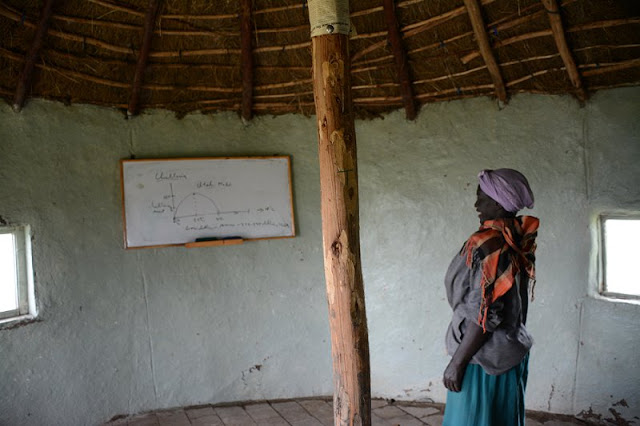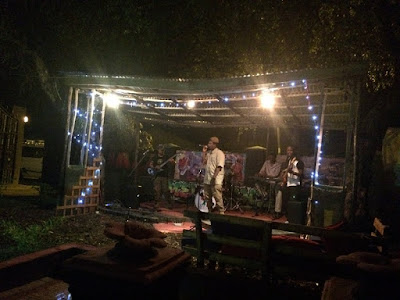Got the opportunity to go out to the countryside for the afternoon with my friend and co-worker Magda. Her family has a farm about 100 km north of the city.
As we left the suburbs of Addis behind the metropolis faded into suburbs and then dwindled away to the occasional town- a group of about 200 homes with the required fruit stands, plastic shops and roadside mechanics. The road winds over the hills surrounding Addis and then slowly climbs to the highlands. The fertile fields that surround Addis slowly change to green rocky highlands scattered with family groupings of traditional homes, the rocky fields patchworked with crops and mixed herds of goats, sheep, and cows watched over by children. There are two very distinct herding styles.. the little boy who takes his job very seriously and has the animals all together and on the move, and the mischievous child doing handstands in the field while the animals are scattered everywhere.
The highlands high altitude is deceptive. As a high plateau it is not covered with snow capped mountain peaks but rather rolling green hills with the occasional rocky outcropping. But its altitude can not be denied. At 2800 meters the Ethiopian highland is twice as high as Katmandu the capital of Nepal, and sits equal with Quito the capital of Peru, perched high in the Andes. The high altitude has huge effects on the lives of the agrarian peoples of this region. 80-85% of the population of Ethiopia practice farming as their main occupation-producing food to feed their families and livestock and once that demand is met to sell what ever is left. However in the rocky soil and thin air of the highlands what grows is minimal.
Tilling small plots of land with oxen the farmers here mostly grow wheat, barely, beans and lentils. However these crops are so very susceptible to the frost. Main growing season is rainy season June-August with harvest in September. Months of frost are September through to January when polar winds sweep the highlands during the first half of dry season. When planting is delayed for various reasons mostly related to weather the harvest times creeps into the frost season and entire crops are lost. In recent years, changing weather patterns has really been challenging to this timelines which stretches back centuries. While a large portion of the east region of Ethiopia is close to drought due to lack of the summer rains, this region faces unique challenges.
Magda's father for the past 10 years has working hard to devise ways to grow other crops in this harsh environment. While these crops will not exclusively feed families they would provide valuable cash crops that they could sell He is working with apples, pears and olives. 10 years ago he started with a small orchard of 1 variety of apple which bears fruit once a year and then a few years ago has been working with root stock and breeding other varieties which bear fruit in July and then again in January. He works hard at the education of those who would benefit most from his work- inviting his neighbours for formal training of the planting, care, and harvesting of the crops. Others in the agiculureal world in Ethiopia are also excited of the work he is pioneering. NGO's concerned with food security and sustainability are partnering with him to educate others as well. He is also working with agriculturalist at the university working with using different herbs for pest control.
The FarmHouse
Daily rains and storms of the season-
Before we got to work we had lunch and coffee first- Ethiopian Culture is one which really celebrates eating and drinking together. Injera and Coffee are the staples of any gathering.
The thunder rumbled ahead for the entire afternoon.
Here you can see the rocky ground which makes plowing, growing and maintain fields a challenge.
Wheat and grass are harvested to feed the animals and stacked to protect it from the elements
Anyone who knows me know I love the donkeys... so nice to see one not in the concrete jungle
a little size perspective for how massive the mounds of grass and wheat are.
Olive trees frame the old home on the property that now doubles as a class room for local farmers to learn about apple farming
While right now the grass is green and wet, the trees require irrigation in the dry season. The high fence protects the apples from the antelope that roam the plateau
Thunder or not we headed out to the orchard to pick

So passionate about his trees and plans he has for the future
Apple trees just our size!!
Hail like that which fell later that day wrecks havoc on the smooth skin of the apples
mmmm pears!!!! I never thought I would get sick of mangos but nothing like a good pear to remind you of fruit from home!!
And then suddenly the rain that the thunder had warned about for the previous three hours fell!!!. Suddenly it is dark and pouring!!!
Magda's mom has been so great- hospitable, welcoming me into their family. She is wonderful kind women who loves to entertain, garden, and garden. - forgive the huge waterspot on the lense!!!
When it rains it rains!!!!
As we got in the car to drive home, the rain changed to hail. It pounded down for about 10 mins and I couldn't help but think about the apples still on the trees, the newly sprouted barley, and all those depending on them for food and security. Living by the land has huge rewards (it was heaven to be out of the city for the day) but also huge risks and life altering consequences when things beyond your control go wrong. There are no second chances there is only 12 months to wait until you can try again and in between the uncertainty of sustenance.






























































































